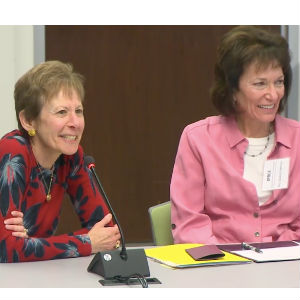
From left, Steinberg and Herman.
The Interagency Pain Research Coordinating Committee (IPRCC), the nation’s highest-level pain policy committee, convened on the campus of the National Institutes of Health (NIH) on Nov. 16 for its second meeting of 2018. U.S. Pain Foundation has two appointees on this prestigious committee: Cindy Steinberg, national director of policy and advocacy, and Gwenn Herman, clinical director of Pain Connection.
“In the three years that I’ve served on the IPRCC, I have to say this is the most hopeful time for people living with chronic pain,” Steinberg said in her remarks at the meeting. “I equate basic research with hope.”
Steinberg discussed the exciting potential of a recent $250 million investment from Congress into NIH research on chronic pain as part of the HEAL Initiative. She cautioned that it will take time before these investments translate to improved outcomes.
“The reality is that pain continues to be a waste of human potential and a waste of health care expenditure. It condemns many Americans to live a lonely life of tremendous suffering.”
Steinberg went on to discuss the work and soon-to-be-released draft report of the Health and Human Services (HHS) Interagency Pain Management Best Practices Task Force, of which she is a part. She stated that the report recommendations will stress the necessity of individualization of care in the selection of therapies tried, the consideration of risks and benefits of therapies, the duration of treatment, and the optimal dosing of medication. A significant portion of the report will focus on pain in special populations of patients, including the elderly, children, veterans and members of the military, and others. Read Steinberg’s full comments here.
During the meeting, the committee heard updates from federal health agency members, including the Centers for Disease Control and Prevention, the Agency for Healthcare Research and Quality, the Food and Drug Administration, and HHS, regarding new developments at the agencies about pain management. But the biggest news pertained to the HEAL Initiative.
Dr. Walter Koroshetz, chair of the IPRCC and director of the National Institute of Neurological Disorders and Stroke, described activities recently begun thanks to the HEAL Initiative. As part of that effort, NIH will support research projects to discover and validate novel targets at all levels of the pain processing pathway. Another very important avenue of research that is part of the HEAL Initiative is the search for biomarkers for pain. These would provide objective evidence of the existence of pain, a holy grail that has long eluded pain researchers and patients alike. To reduce time and risk associated with conducting Phase II Clinical Trials, HEAL will establish a clinical trials network with a coordinating center, data center and hubs able to recruit participants with specific pain conditions.
An additional exciting development in the world of pain research was the announcement in the summer that pain was awarded a Common Fund project. Granted by the Office of the Director of NIH, Common Fund research awards are highly competitive. The Acute to Chronic Pain Signatures project will seek to understand how, why, and when acute pain transitions into chronic pain by studying post-surgical and post musculoskeletal trauma patients. Researchers will collect and analyze a comprehensive data set on these patients including neuroimaging, genomics, sensory testing, and psychosocial assessments after the acute pain event to determine which patients will recover and which patients will develop long-lasting chronic pain. The finding from this study will hopefully enable us to predict and perhaps prevent the occurrence of chronic pain in the future.
Finally, news was also shared about an NIH, Department of Defense, and Department of Veterans Affairs Collaboratory, a joint activity aimed at implementing large-scale clinical research of nonpharmaceutical therapies for chronic pain. There are 11 demonstration projects underway examining various complementary therapies for chronic pain.
View a full recording of the meeting here.
